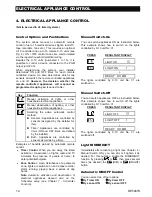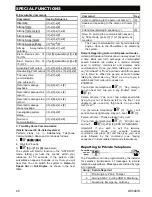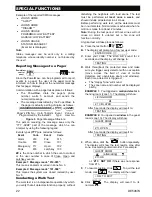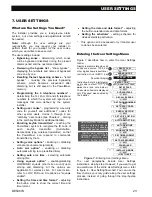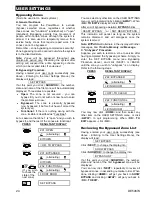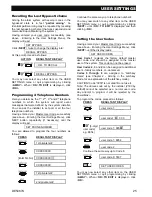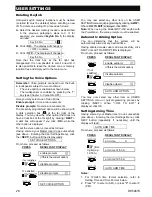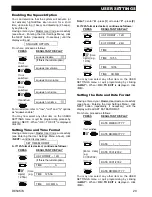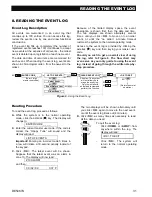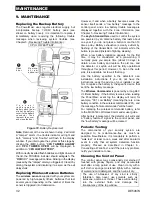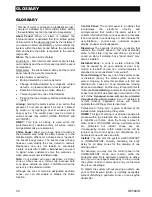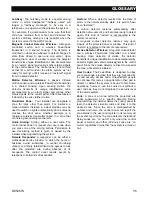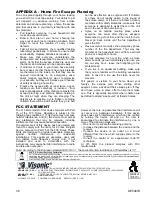
SPECIAL FUNCTIONS
DE5467U
21
Group 1
has the highest priority and group 3 has the
lowest priority.
When the called party answers a call initiated by the
P, he will hear a verbal message
composed of the “house identity” and the type of
event that occurred. For example, once smoke is
detected in the Smith residence, the message will
be:
[The Smith Residence - Fire Alarm].
If a person under surveillance in the Watkins
residence has been inactive, the message will be:
[The Watkins Residence - No Activity].
The called party must acknowledge the message (as
explained later on), but if he does not respond, the
message will be transmitted repeatedly as many
times as possible within a 45-second time limit.
When the 45 seconds are up, the P will
disengage the line and call the next private
telephone number on its list.
The called party can acknowledge the message by
pressing a key on the telephone keypad, as follows.
Command Key
Acknowledge only:
The P
disengages the line and considers the
event duly reported.
2
Acknowledge and listen-in:
The
protected site is “bugged” for sound for
50 seconds. The called party may
prolong the listening session by pressing
[3] again before the P
disengages the line, or by pressing [1] to
speak.
3
Acknowledge and speak out:
The
called party may speak for 50 seconds
to whoever is in the protected site. The
called party may prolong the “speak
out” session by pressing [1] again
before the P disengages the
line, or by pressing [3] to listen.
1
Acknowledge and 2-way conversation:
You and the called party can speak and
listen without any necessity to switch the
system from "listen-in" to "speak-out"
and
vice
versa for 50 sec. (extendable).
6
Acknowledge and request a status
report:
The P will issue a
verbal report of system status. For
example:
[Disarm - ready to arm]
or
[Disarm - back door open]
or
[Disarm - alarm in memory].
9
Remote Control by SMS
P system with GSM unit can respond to
SMS commands from any cellular telephone, only if
the “REM ACCESS ON” command was pre-selected
by the system installer.
The various SMS commands are detailed in the
following table (the detailed SMS message sending
process is described in the cellular telephone user’s
guide). In this table, “<code>” means 4-digit user
code and blank space simply means blank space.
SMS Command List
Command SMS
Format
1
Arm AWAY
“AWAY <code>”
or “AW <code>”
2
Arm AWAY instant “AWAY INST <code>”
or “AWI <code>”
3 Arm
AWAY
Latchkey
“LATCHKEY <code>”
or “LK <code>”
4 Arm
AWAY
Latchkey instant
“LATCHKEY INST
<code>”
or “LKI <code>”
5
Arm HOME
“HOME <code>”
or “HM <code>”
6
Arm HOME instant “HOME INST <code>”
or “HMI <code>”
7
Disarm
“DISARM <code>” or “DA
<code>”
8
Turn light xx on
(xx = 01 – 15)
“LIGHT xx ON <code>”
or “LT xx ON <code>”
9
Turn light xx off
(xx = 01 – 15)
“LIGHT xx OFF <code>”
or “LT xx OFF <code>”
10 Turn PGM on
“PGM ON <code>”
11 Turn PGM off
“PGM OFF <code>”
12 Define custom
house identity (see
note)
“HOUSE NAME <code>
<house ID>”
or “HN <code> <house
ID>”
13 Query system
status
“STATUS <code>” or “ST
<code>”
Note:
House ID includes up to 16 characters, for
example JOHN'S HOUSE.
Reporting by SMS
This option is applicable only if the GSM unit is
installed. The P system can send SMS
messages to a registered SMS telephones (up to 4).
(The SMS telephone registration is preselected by
the system installer).
The reported SMS messages are quite clear and
self- explanatory and therefore are not detailed in
this guide.








